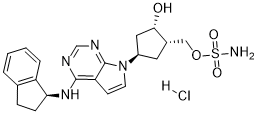Pevonedistat HCl (MLN-4924; TAK-924)
This product is for research use only, not for human use. We do not sell to patients.

For small sizes, please check our retail website as below: www.invivochem.com
| Size | Price | Stock |
|---|---|---|
| 250mg | $1450 | Check With Us |
| 500mg | $2080 | Check With Us |
| 1g | $3120 | Check With Us |
Cat #: V3202 CAS #: 1160295-21-5 Purity ≥ 98%
Description: Pevonedistat HCl (MLN4924; TAK924), the hydrochloride salt of Pevonedistat, is an inhibitor of Nedd8 (Neural precursor cell expressed, developmentally down-regulated 8) activating enzyme (NAE) with IC50 of 4 nM.
Top Publications Citing Invivochem Products
Publications Citing InvivoChem Products
Product Promise

- Physicochemical and Storage Information
- Protocol
- Related Biological Data
- Stock Solution Preparation
- Quality Control Documentation
| Molecular Weight (MW) | 479.98 |
|---|---|
| Molecular Formula | C21H26ClN5O4S |
| CAS No. | 1160295-21-5 |
| Storage | -20℃ for 3 years in powder formr |
| -80℃ for 2 years in solvent | |
| Solubility In Vitro | DMSO: >100 mg/mLr |
| Water: N/Ar | |
| Ethanol: N/A | |
| SMILES Code | [H]Cl.O=S(OC[C@H]1[C@@H](O)C[C@H](N2C=CC3=C(N[C@H]4CCC5=C4C=CC=C5)N=CN=C32)C1)(N)=O |
| Synonyms | MLN-4924 HCl; TAK 924 HCl; MLN4924 HCl; TAK924 HCl; Pevonedistat HCl; TAK-924 HCl |
| Protocol | In Vitro | Pevonedistat (MLN4924) is a potent inhibitor of NAE (half-maximal inhibitory concentration (IC50=0.004 μM), and is selective relative to the closely related enzymes UAE, SAE, UBA6 and ATG7 (IC50=1.5, 8.2, 1.8 and >10 μM, respectively). Pevonedistat (MLN4924) treatment inhibits overall protein turnover in cultured HCT-116 cells. Treatment of HCT-116 cells with Pevonedistat (MLN4924) for 24 h results in a dose-dependent decrease of Ubc12-NEDD8 thioester and NEDD8-cullin conjugates, with an IC50 < 0.1 μM, resulting in a reciprocal increase in the abundance of the known CRL substrates CDT1, p27 and NRF2 (also known as NFE2L2), but not non-CRL substrates. |
|---|---|---|
| In Vivo | Pevonedistat (MLN492410, 30 or 60 mg/kg, s.c.) leads to a dose- and time-dependent increase in the steady state levels of NRF2 and CDT1 in HCT-116 tumour-bearing mice, and decreases NEDD8-cullin levels in normal mouse tissue as illustrated in mouse bone marrow cells. Pevonedistat (MLN4924) administered on a BID schedule at 30 and 60 mg/kg inhibits tumour growth with T/C values of 0.36 and 0.15, respectively. |
These protocols are for reference only. InvivoChem does not
independently validate these methods.
| Solvent volume to be added | Mass (the weight of a compound) | |||
|---|---|---|---|---|
| Mother liquor concentration | 1mg | 5mg | 10mg | 20mg |
| 1mM | 2.0834 mL | 10.4171 mL | 20.8342 mL | 41.6684 mL |
| 5mM | 0.4167 mL | 2.0834 mL | 4.1668 mL | 8.3337 mL |
| 10mM | 0.2083 mL | 1.0417 mL | 2.0834 mL | 4.1668 mL |
| 20mM | 0.1042 mL | 0.5209 mL | 1.0417 mL | 2.0834 mL |
The molarity calculator equation
Mass(g) = Concentration(mol/L) × Volume(L) × Molecular Weight(g/mol)
Mass
=
Concentration
×
Volume
×
Molecular Weight*
The dilution calculator equation
Concentration(start)
×
Volume(start)
=
Concentration(final)
×
Volume(final)
This equation is commonly abbreviated as: C1 V1 = C2 V2
Concentration(start)
C1
×
Volume(start)
V1
=
Concentration(final)
C2
×
Volume(final)
V2
Step One: Enter information below
Dosage mg/kg
Average weight of animals g
Dosing volume per animal µL
Number of animals
Step Two: Enter the in vivo formulation
%DMSO
+
%
+
%Tween 80
+
%ddH2O
Calculation Results:
Working concentration:
mg/ml;
Method for preparing DMSO master liquid:
mg
drug pre-dissolved in
µL
DMSO(Master liquid concentration
mg/mL)
,Please contact us first if the concentration exceeds the DMSO solubility of the batch of drug.
Method for preparing in vivo formulation:
Take
µL
DMSO master liquid, next add
µL
PEG300, mix and clarify, next add
µL
Tween 80,mix and clarify, next add
µL
ddH2O,mix and clarify.
Note:
- (1) Please be sure that the solution is clear before the addition of next solvent. Dissolution methods like vortex, ultrasound or warming and heat may be used to aid dissolving.
- (2) Be sure to add the solvent(s) in order.




































